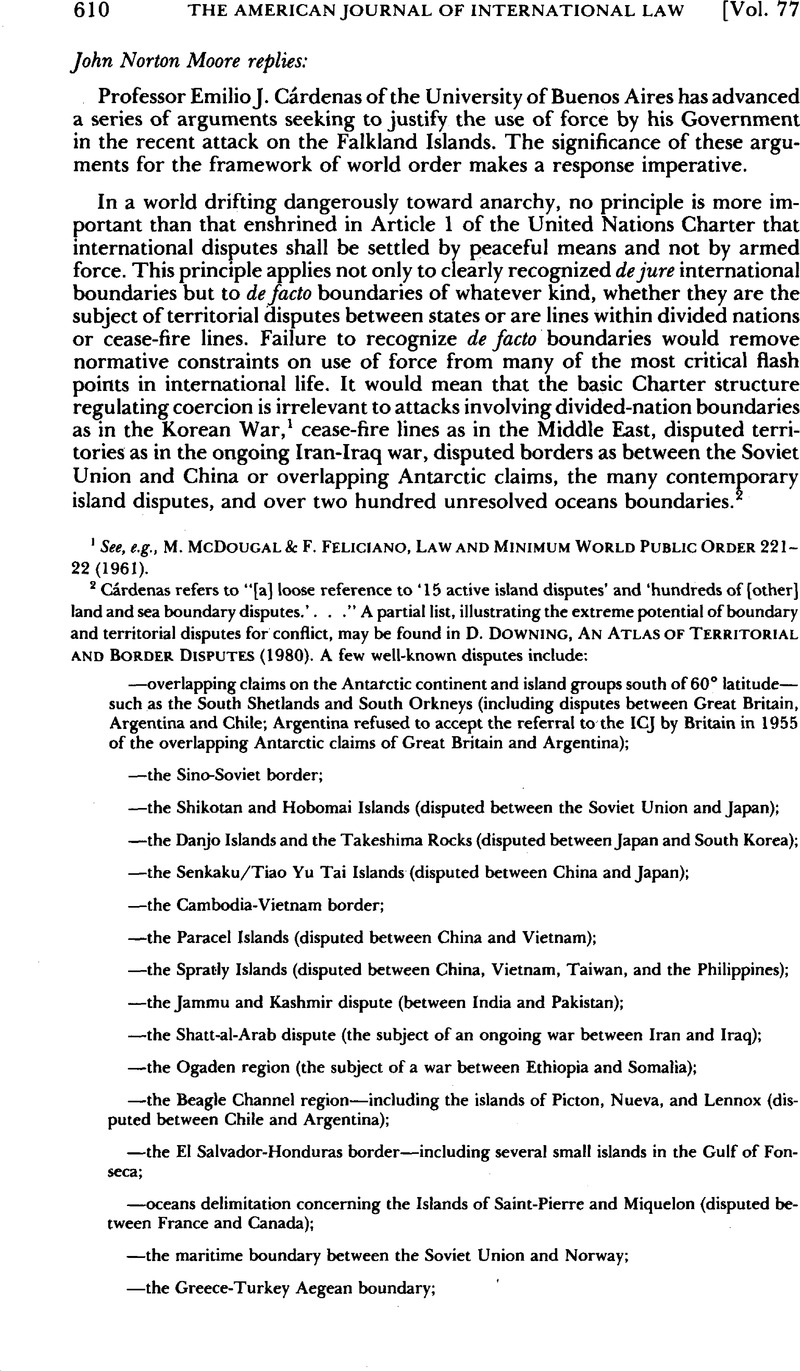Article contents
[no title]
Published online by Cambridge University Press: 22 March 2017
Abstract

- Type
- Notes and Comments
- Information
- Copyright
- Copyright © American Society of International Law 1983
References
1 See, e.g., Mcdougal, M. & Feliciano, F., Law and Minimum World Public Order 221–22 (1961)Google Scholar.
2 Cárdenas refers to “[a] loose reference to ‘15 active island disputes’ and ‘hundreds of [other] land and sea boundary disputes.’. . .”A partial list, illustrating the extreme potential of boundary and territorial disputes for conflict, may be found in Downing, D., An Atlas of Territorial and Border Disputes (1980)Google Scholar. A few well-known disputes include:
—overlapping claims on the Antarctic continent and island groups south of 60° latitude— such as the South Shetlands and South Orkneys (including disputes between Great Britain, Argentina and Chile; Argentina refused to accept the referral to the ICJ by Britain in 1955 of the overlapping Antarctic claims of Great Britain and Argentina);
—the Sino-Soviet border;
—the Shikotan and Hobomai Islands (disputed between the Soviet Union and Japan);
—the Danjo Islands and the Takeshima Rocks (disputed between Japan and South Korea);
—the Senkaku/Tiao Yu Tai Islands (disputed between China and Japan);
—the Cambodia-Vietnam border;
—the Paracel Islands (disputed between China and Vietnam);
—the Spratly Islands (disputed between China, Vietnam, Taiwan, and the Philippines);
—the Jammu and Kashmir dispute (between India and Pakistan);
—the Shatt-al-Arab dispute (the subject of an ongoing war between Iran and Iraq);
—the Ogaden region (the subject of a war between Ethiopia and Somalia);
—the Beagle Channel region—including the islands of Picton, Nueva, and Lennox (disputed between Chile and Argentina);
—the EI Salvador-Honduras border—including several small islands in the Gulf of Fonseca;
—oceans delimitation concerning the Islands of Saint-Pierre and Miquelon (disputed between France and Canada);
—the maritime boundary between the Soviet Union and Norway;
—the Greece-Turkey Aegean boundary;
—the continuing division between China and Taiwan (of China?);
—the continuing division of Germany;
—the continuing division of Korea; and
—continuing cease-fire lines and de facto boundaries in the Arab-Israeli conflict.
Unfortunately for world order, there is nothing “loose” about the existence of these and many other boundary and territorial disputes and their potential for conflict. In this respect the introduction by David Downing to his atlas of territorial and border disputes is instructive:
Border disputes provide an all too-convenient platform for the expression of international hostility, and waving the flag and waxing lyrical about the nation’s sacred soil are timehonoured methods of silencing internal opposition. . . . But however invidious the role of governments, it cannot be denied that the very existence of ill-drawn borders has played a major role in the fomentation of all this century’s major wars.
Id. at 8.
With respect to oceans boundary disputes, Dr. Robert D. Hodgson, the late Geographer of the Department of State, wrote in 1978:
Over 70 maritime boundaries have been negotiated to date. More than 240 have either not undergone negotiation, are in the process of negotiation, and/or are disputed. Approximately one of five potential maritime limits has been agreed upon, although many of these delimitations, it should be noted, remain incomplete. . . .
Seventy-three maritime boundary disputes have been presently identified. Many of these disputes remain latent and they may not change from the quiescent state until solutions are found. Moreover, over one-third—25 may be so categorized—involve overlapping claims to land territory. Due to this complication, the twenty-five should not be deemed to be maritime boundary disputes in the strictest sense even though the desire to expand control over ocean resources may underlie certain of these disputes. In contrast, others of these derive from prior, in many cases long-standing, disagreements over land boundaries, sovereignty over islands or similar problems.
Hodgson, , International Oceans Boundary Disputes, Oceans Pol’y Study, No. 4, April 1978, at 37, 38Google Scholar.
5 Franck, , Dulce et Decorum Est: The Strategic Role of Legal Principles in the Falklands War, 77 AJIL 109 (1983)CrossRefGoogle Scholar.
4 Ambassador Edmonde Dever, UN Doc. S/PV.2363, at 48–50 (1982).
5 Hassan, , The Sovereignty Dispute aver the Falkland Islands, 23 Va . J. Int’l L. 53, 64–65 (1982)Google Scholar.
6 Jesnings, R., The Acquisition of Territory is International Law 72–73 (1963)Google Scholar. Professor Jennings also adds:
In actual cases the issue is seldom as simple as the case which rests upon strictly legal arguments relative to the existence in law of a present title. Almost invariably the case will be mixed, including legal arguments to establish a present title, and political arguments, i.e. arguments the true tendency of which is that even if the present title is in another it ought to be shifted to the claimant. Now it is perfectly clear that the latter class of argument, be it never so strong and persuasive, cannot, if standing alone, justify in law the use of force to repossess. On the contrary, it is tantamount to an admission that the present legal title is elsewhere; and if that is the position an attempt at self-help must be forbidden by the law.
Id. at 73.
7 See UNGA Res. A/2065 (XX) (1965), and A/3160 (XXVIII) (1973).
8 See the excellent note by Maguire, , The Decolonization of Belize: Self-Determination v. Territorial Integrity, 22 VA. J. Int’l L. 849 (1982)Google Scholar.
9 It might also be noted that the case of Gibraltar, which Professor Cardenas relies on for support, seems to undercut rather than support his case. For in the Falklands case, unlike that of Gibraltar, the United Nations has not made a determination that the local population should be ignored. Rather, it has expressly called for the need to bear in mind “the interests of the population of the Falkland Islands” in the decolonization process. See the resolutions cited in note 7 supra.
- 1
- Cited by




